The AMD Threadripper 2 CPU Review: The 24-Core 2970WX and 12-Core 2920X Tested
by Ian Cutress on October 29, 2018 9:00 AM ESTHEDT Performance: Rendering Tests
Rendering is often a key target for processor workloads, lending itself to a professional environment. It comes in different formats as well, from 3D rendering through rasterization, such as games, or by ray tracing, and invokes the ability of the software to manage meshes, textures, collisions, aliasing, physics (in animations), and discarding unnecessary work. Most renderers offer CPU code paths, while a few use GPUs and select environments use FPGAs or dedicated ASICs. For big studios however, CPUs are still the hardware of choice.
All of our benchmark results can also be found in our benchmark engine, Bench.
Corona 1.3: Performance Render
An advanced performance based renderer for software such as 3ds Max and Cinema 4D, the Corona benchmark renders a generated scene as a standard under its 1.3 software version. Normally the GUI implementation of the benchmark shows the scene being built, and allows the user to upload the result as a ‘time to complete’.
We got in contact with the developer who gave us a command line version of the benchmark that does a direct output of results. Rather than reporting time, we report the average number of rays per second across six runs, as the performance scaling of a result per unit time is typically visually easier to understand.
The Corona benchmark website can be found at https://corona-renderer.com/benchmark
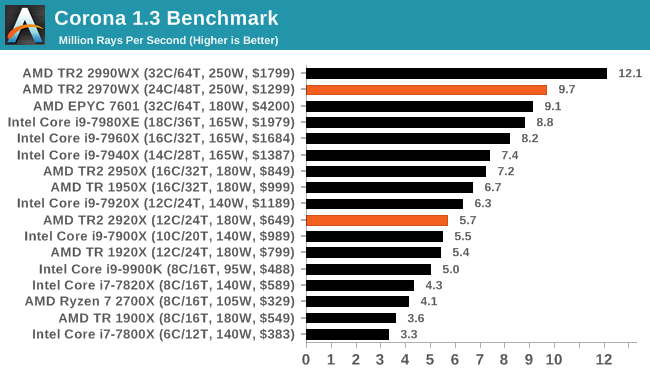
Corona scales well with cores, although memory bandwidth also helps. The 2970WX sits behind the 2990WX amd the 2920X sits behind the 2950X, as expected.
Blender 2.79b: 3D Creation Suite
A high profile rendering tool, Blender is open-source allowing for massive amounts of configurability, and is used by a number of high-profile animation studios worldwide. The organization recently released a Blender benchmark package, a couple of weeks after we had narrowed our Blender test for our new suite, however their test can take over an hour. For our results, we run one of the sub-tests in that suite through the command line - a standard ‘bmw27’ scene in CPU only mode, and measure the time to complete the render.
Blender can be downloaded at https://www.blender.org/download/
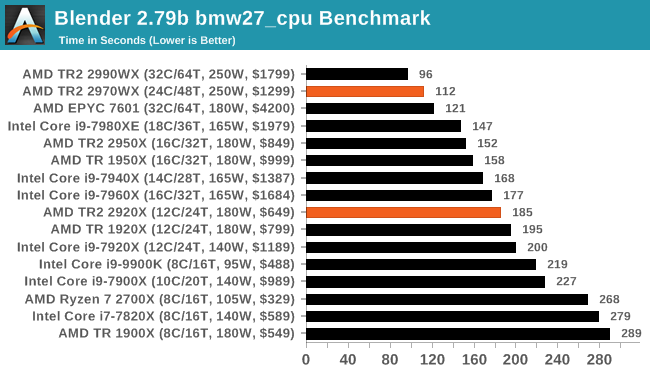
Blender is also another render that likes a mix of cores and memory, being able to put all of the the 2990WX cores to good use. The 2970WX also comes in under two minutes on this test, while the 2920X only just beats the previous generation 1920X.
LuxMark v3.1: LuxRender via Different Code Paths
As stated at the top, there are many different ways to process rendering data: CPU, GPU, Accelerator, and others. On top of that, there are many frameworks and APIs in which to program, depending on how the software will be used. LuxMark, a benchmark developed using the LuxRender engine, offers several different scenes and APIs.

Taken from the Linux Version of LuxMark
In our test, we run the simple ‘Ball’ scene on both the C++ and OpenCL code paths, but in CPU mode. This scene starts with a rough render and slowly improves the quality over two minutes, giving a final result in what is essentially an average ‘kilorays per second’.
It has been pointed out to us that LuxMark is affected by the Spectre/Meltdown patches, so consider this more of a synthetic test of different code paths.
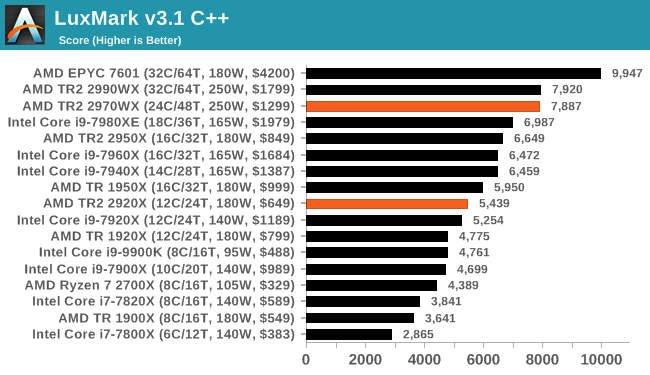
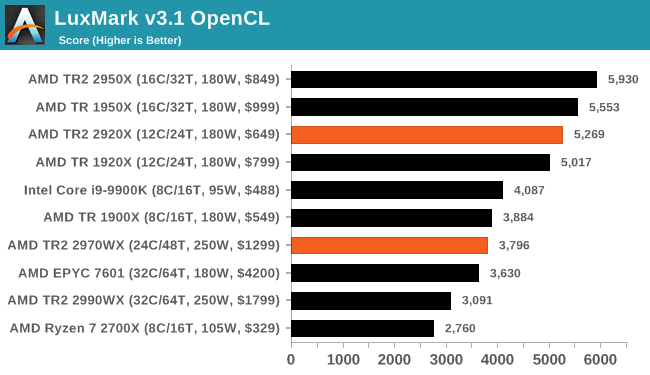
LuxMark in C++ mode seems to be able to take advantage of the extra memory bandwidht on the EPYC platform. Our Skylake-X processors never seem to be able to run the OpenCL model, but we see there are problems above 16 cores in this part of the test.
POV-Ray 3.7.1: Ray Tracing
The Persistence of Vision ray tracing engine is another well-known benchmarking tool, which was in a state of relative hibernation until AMD released its Zen processors, to which suddenly both Intel and AMD were submitting code to the main branch of the open source project. For our test, we use the built-in benchmark for all-cores, called from the command line.
POV-Ray can be downloaded from http://www.povray.org/
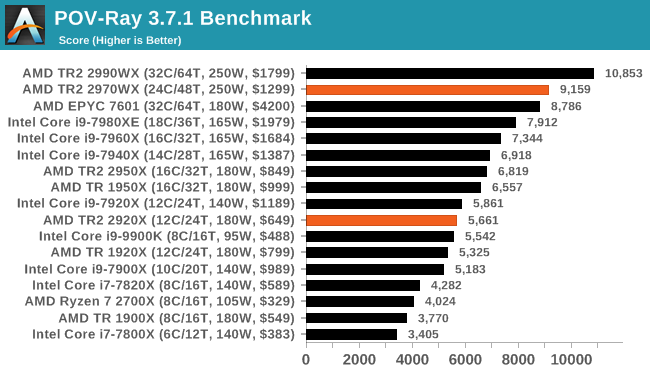


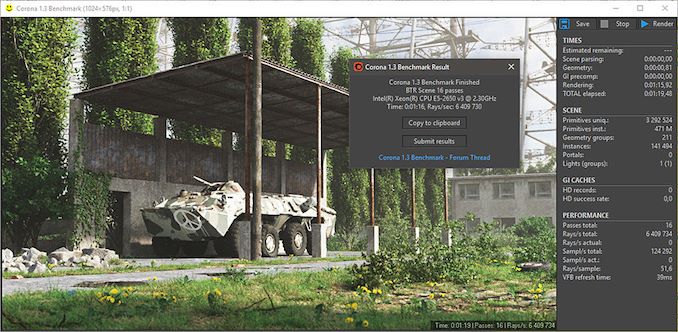








69 Comments
View All Comments
The Hardcard - Monday, October 29, 2018 - link
I am not clear on this: can I get a 4-active-die TR for rendering and then turn off the 2 parasite dies when they are a disadvantage. Say make the 2990X operate as a 2950X with the same performance and power?I am not clear if that is what the dynamic local mode is offering. I’d like to be able to do that, whether there is an official AMD path, or if the community finds another way.
BikeDude - Monday, October 29, 2018 - link
<blockquote>Please note, if you plan to share out the Compression graph, please include the Decompression one. Otherwise you’re only presenting half a picture.</blockquote>Many moons ago I made a request to internal IT to adopt 7-zip so that I could save on bandwidth whenever I needed to pull a largish database (this was several years before GDPR obviously).
No go. It turned out that compressing the backups every night eats a lot of time. (decompressing these files was very fast regardless of setup) Well, actually they did use 7z.exe, but only as a normal zipper.
So sometimes the only relevant part of the equation is the compression time. (I do plan on purchasing AMD regardless for my next upgrade)
GreenReaper - Wednesday, October 31, 2018 - link
Use a threading-capable version of xz with the -T parameter so it uses all available threads and you'll find it flies on the default compression settings. It has a Windows version, too: https://tukaani.org/xz/GreenReaper - Wednesday, October 31, 2018 - link
Incidentally, you can probably run it something like xz < "input command" > output.xz, which should mean you don't actually have to write the dumps out, just the compressed version.PaoDeTech - Monday, October 29, 2018 - link
I need 13 cores and 26 threads. Now what? I returned the 32 cores 64 threads one since it could not run FAR CRY at 60fps. But boy could it blend! Sarcasm aside, I write multi-threaded server software and unless I code an infinite loop by mistake (I'm NOT admitting to it) I can never max out 8 threads before hitting I/O limitations (on NVMe PCIe disk). But I can see how some number crunching parallel software would go to town with it.peevee - Wednesday, October 31, 2018 - link
"I can never max out 8 threads before hitting I/O limitations (on NVMe PCIe disk)"Do you know these are IO limitations or do you assume this? Because lack of scaling after 8 threads does not mean IO limit at all. For example, if you write in Java/C#/Python/JS etc (heap-mandatory languages), or even use heap alloc/dealloc in critical thread sections in fast languages like C++, this is what you are going to get (heap mutex = no scalability). And this is just 1 of a thousand pitfalls of massive threading.
PaoDeTech - Thursday, November 1, 2018 - link
No locks, every client call gets its own thread (REST- IIS -WebAPI -.NET "stateless" server - Entity Framework - SQL Server with read committed snapshot isolation). Async all the way down. Under load I can see the disk active >50% and write speed maxes out at 7 MB/s (Toshiba NVMe PCIe 1TB SSD M2). All processes running on the same PC (i7 6700k - 32GB RAM): server, test clients, SQL server. Plenty of free ram.Of course performance optimization is in the details and I was referring to a specific write intensive test case. My point is that parallel scaling is not easy and may stop sooner than expected (for many reasons). On the other hand, I can always use faster single thread performance...
29a - Monday, October 29, 2018 - link
Please replace EgoMark (3DPM) with something else, anything else.danjw - Monday, October 29, 2018 - link
Are there any motherboards out there that support the security features of the Threadripper platform?SLVR - Monday, October 29, 2018 - link
This review is a bit more useful: https://www.techspot.com/review/1737-amd-threadrip...